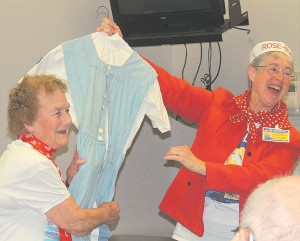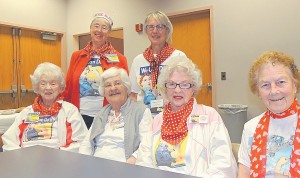Article and Photos Courtesy of JON STINNETT, The Cottage Grove Sentinel
For those who did not live through those times, it can be difficult to imagine the reality of a total worldwide war requiring the efforts of all of a nation’s citizens to ensure victory. On Wednesday, April 8, a panel of four local ladies came to the Cottage Grove Community Center to share their stories of such times and the efforts each played in helping overcome the enemy during World War II.

“It still fits!” — Rosie the Riveter Opal Nelson (left) and ARRA President Yvonne Fasold show off Nelson’s Red Cross uniform.
America’s Rosie the Riveters have since become a cultural icon, the symbol of the real-life women who entered the workforce or changed professions during the war to take positions vacated by men fighting overseas. The term was coined in 1942 with a song by Redd Evans and John Jacob Loeb that became a national hit, and the image of a woman in a red bandana operating a rivet gun is still recognizable to many today.
But much like their male counterparts, the real-life Rosie the Riveters are advancing past the age of 90 and are passing away at alarming rates, according to Yvonne Fasold, herself a “Rosebud,” the descendant of a Rosie, who also serves as the President of the American Rosie the Riveters Association. Sisters Fasold and Corolene Corriea also spoke of their connection to the Rosies at last week’s presentation, organized by the Cottage Grove Genealogical Society, which found a nice crowd on hand to hear the stories of local Rosies.
“Our two main ARRA goals are to honor the women and to preserve their legacy,” Fasold said. “To do that, we need to spread the word and involve younger generations. When we talk to schools, it becomes ‘living history.’”
Fasold pointed out that many local Rosie the Riveters have passed away recently, mentioning Betty Fisher and Maggie Porter with a catch in her voice. Fasold credited Opal Nelson, one of Cottage Grove’s most recognizable Rosies, with helping her decide to pursue the presidency of the national organization.
“Once I met this group, I knew I had to step up,” she said. There are about 15 Rosies that remain active in the Eugene chapter of AARA, Fasold said, and three of the four Rosies with Cottage Grove ties were on hand to share their stories Wednesday, minus Arlene Williams. Cottage Grove’s Alice Heiney is proud to be the oldest local Rosie at age 97, and Doris Graham and Nelson also shared their stories, in addition to Springfield’s Lorette Wedlake.
Heiney brought along a cartridge of the type she inspected during the war. She and others would inspect the weight and gauge of each bullet before placing it in a big hopper bound for another part of the Denverbased factory. Heiney said that all those working there were a patriotic bunch. She added that it was difficult during those times to obtain housing for working mothers.

‘Rosebuds’ Yvonne Fasold, ARRA President, and Corolene Correia (top row) with Rosies Alice Heiney, Lorette Wedlake, Doris Graham and Opal Nelson.
Wedlake spoke of employment at a much younger age. The war caused a shortage of fuel that left farmers exploring their options for harvest without gasoline-powered farm implements. Wedlake was one of many Massachusetts teens hired for about four hours a day to harvest acres of carrots, beets, spinach, corn and tomatoes.
Doris Graham’s presentation included tales of several brushes with celebrity. In June of 1942, the day before she graduated high school, Graham took a job with the U.S. Treasury Department in Washington, D.C., where she would type war bonds for the better part of three years. Previously a “farm girl,” Graham spoke of her view of the White House grounds and her father’s position with the Secret Service. During that time, she met stars such as Marlene Dietrich and Maureen O’Hara and shook the hand of First Lady Eleanor Roosevelt during an inaugural ball.
Nelson shared the news that she was an actual riveter during the war, though she could have had a number of jobs back then.
“Everybody was hiring,” she said. “You didn’t have to look for a job; they came to you.”
Nelson eventually took a position with Douglas Aircraft riveting together the fuselages of airplanes in places where machines couldn’t reach.
“Sometimes we’d get to go out to the runway,” she said. “They’d give us five to 10 minutes to look at the airplanes and put our names on them (and maybe our phone numbers.”
Nelson appreciated the work but eventually sought a position with the Red Cross. She showed the Cottage Grove crowd her uniform from that time, emblazoned on one sleeve with the Red Cross insignia.
“It still fits,” Nelson said with a laugh, “as long as I don’t button it.”
